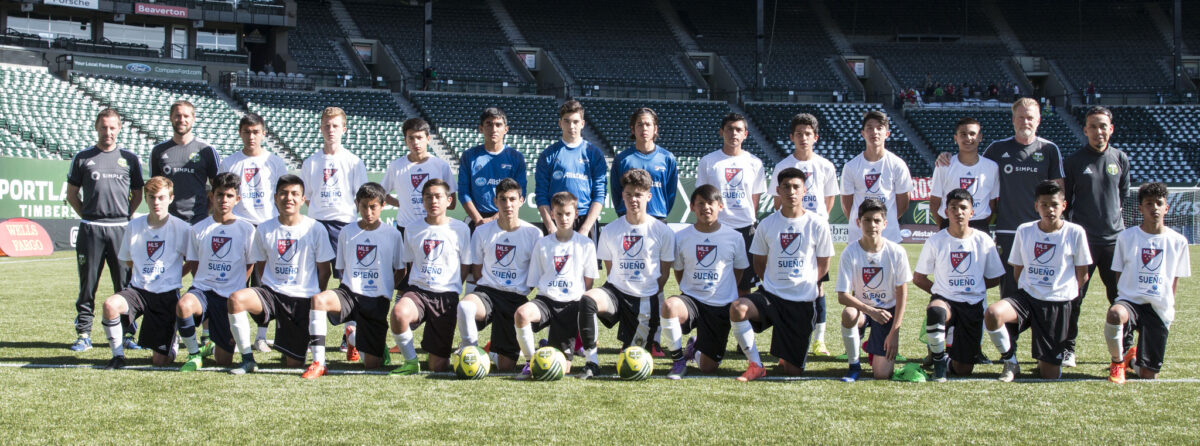When Major League Soccer kicked off in the spring of 1996, one of its trademark features was its uniqueness.
In Europe, every league from England to Belarus is steeped in decades, even centuries of tradition. Meanwhile, MLS came into existence as an afterthought in a country with its own distinct sporting culture. To succeed, the league needed to find a way to stand out.
Run-up penalty shootouts; flashy, un-soccer-y team names like the Wizards and the Crew; and an actual playoff competition to crown a league champion. You name it, MLS tried it. So in 2007, when the concept of a reality-television-style competition to find the best young players in the country was pitched to the league, it was naturally given the green light.
That initial concept became Sueño MLS, a competition that lasted exactly a decade with varying degrees of success. The winner of that inaugural 2007 season was Jorge Flores, a young defender from Anaheim, California, who earned a spot in the Chivas USA academy. Today, Flores—nicknamed Sueño after winning the competition—goes by another surname: Villafaña.
In 2016, the competition named Portland, Oregon as one of its three first-round “host” cities for the first and only time. Up to 400 young players were allowed to participate, and six players (five field players and a goalkeeper) were then selected to travel to Los Angeles, California to take part in drill work and compete in scrimmages against local academies during a four-day finals.
Yet, despite its billing as a big-time competition, many of Portland’s finalists learned about Sueño MLS through happenstance. Andres Labate, a 15-year-old from Salem, heard about the event through his Argentinian father who heard an ad for the competition over the radio. 16-year-old Jonathan Reynoso, who lived in Madras, said that he heard about the competition through a friend at the very last minute.
On Sunday, April 16, hundreds of young players from around the region spent a beautiful, sunny afternoon at a Gresham public park in front of experienced evaluators, including Larry Sunderland—then the Portland Timbers Academy and Youth Technical Director, who took part in the competition twice when he worked for Chicago Fire—and Ryan Miller, an academy coach.
According to multiple players, the field in Gresham wasn’t ideal. Faded green with chunks of grass out of place, players claimed that it was difficult to dribble and play precise passes. But even the field couldn’t take away from what Miller called a “soccer-rich environment.” He said what really stood out while watching the scrimmages all day was the excitement among the players and an atmosphere that involved plenty of families hanging around for hours and even picnicking at the park. Labate claimed that the day felt like a scrappy and competitive club tryout, while Reynoso recalls being split into different teams and playing with a lot of different players.
After the first tryout wrapped up, participants were told to expect a phone call later that night, if they advanced. While some players could tell by their performance whether or not they would be invited back, Sunderland and Miller left Reynoso sweating until the last minute.
“I was on my way home and I was thinking that I wasn’t going to go back the next day,” Reynoso said. “It was already eight p.m., nine p.m., but then I got the call.”
Those who received a call that night were invited to Providence Park, where evaluators further trimmed the field to just six finalists, who would represent Portland at the finals in LA. Once again, the tryout consisted mainly of scrimmages—and even involved Timbers forward Dairon Asprilla, who showed up to support the young players.
“There was a lot of pressure,” Reynoso said. “All those people there and it being in an actual stadium. It was fun though.”
Many talented players tried out that week, but there was one clear standout, and everyone knew it: Alan Gaytan. The 15-year-old from Troutdale was athletic, had a great left foot, and quickly impressed evaluators and television crew alike.
“It was pretty clear that of the kids that were there, he stood out,” Sunderland said. “He was dangerous, he could run the ball pretty well, he was good in the one-vs-one. At that Sueño level and that tryout level, he stood out to us.”
Gaytan, who ended up winning the entire competition a few weeks later, excelled at cutting in from the right and curling his shot into the corner of the net. “It was an easy pick,” Sunderland said.
The rest of the selections were not as straightforward. To come up with the other five finalists, evaluators had to scrutinize seemingly minute details.
“It comes down to moments,” Sunderland explained. “It’s easy to find the very top and identify the bottom third. It’s that grey area between the top grouping and the middle grouping. It’s catching the right moments, seeing the right thing, being able to identify potential versus performance. Unfortunately, when you do a tryout like [Sueño MLS], a lot of time you are looking for performance because you do not have enough time to judge potential.”
Added Miller: “Alan was a clear standout in the event because he was an athletic player, he was fast, he was left-footed, he was playing with joy. There weren’t too many questions about him.”
Shortly following the conclusion of the final scrimmage, players were called to the field where Sunderland and Miller officially announced the six finalists. Gaytan, Reynoso, and Labate were called up, along with midfielder Arturo González Vásquez, goalkeeper Antonio Campos, and defender Salvador Pérez. With excited family members in the surrounding stands, many participants called this their favorite moment of the weekend.
“I thought I played well, but I got really tired at the end,” Labate said. “My dad was there and we discussed it. I went down there, and I knew Alan [Gaytan] was going to get picked, but I was not sure about anyone else. It felt amazing to be selected.”
“If I were the director of Sueño, the atmosphere is what I would put my hat on,” Miller said. “That culture and environment that was created, I thought that was really cool.”
When asked about the final selection, Reynoso chuckled. He knew that he would be selected before the official announcement due to being accidentally tipped off on his way back from a water break. The forward admittedly didn’t know what he was seeing at the time other than his name on a computer screen, but he got a good idea as soon as the woman using the laptop quickly shut the screen.
“Once the game finished, I don’t know why, I was just behind everyone,” Reynoso said. “I was looking at the computer and they had the names written down already. So I saw my name on there way before [everyone else].”
Over the course of a decade, 11 separate players have gone on to win the competition. However, not every winner has gone on to find mainstream success in soccer. In 2015, Villafaña went on to win an MLS Cup in Portland and has earned a few international caps for the United States. Gabriel Funes Mori won the competition in 2008 and has since played the role of prolific striker for River Plate, Benfica, and Monterrey. Other winners are still in college, local academies, or are not playing soccer anymore.
“At that time I didn’t see [winning the competition] as pressure, I saw it as an opportunity, which I think is different,” Villafaña admitted. “I imagine every kid’s dream is to be a professional soccer player, and when I won I didn’t see it as pressure, I saw it as an opportunity to be a professional soccer player. That is what my drive was to keep me going. That I had this opportunity that I always wanted.”
Many other players echoed a similar sentiment of how Sueño MLS, as niche a competition as it was, influenced their soccer paths.
Labate, who is committed to playing soccer at Gonzaga University next year, knows that the competition helped him get noticed by the division-one school in the first place.
“Oh, for sure,” Labate said when asked to reflect on the competition’s impact. “Academy level compared to club is a step up, as well as, the connection to college coaches is better. The amount of people who I have gotten into contact with and the connections that I have made were all through the academy and the fact that I played there.”
In an interview back in 2016, Villafaña told MLS.com that “If it wasn’t for the Sueño MLS, I probably would’ve gone to college and I don’t know what would’ve happened. But I’m sure I wasn’t going to be playing professionally.”
Today, Sueño MLS no longer exists. After ten competitions, 2016 was the final run of a soccer reality-television show. And, in its final iteration, the competition gave the country a taste of just what talent can come out of the Pacific Northwest.
“It’s tough because [winning the competition] doesn’t mean that you made it,” Villafaña said when asked about the primary lesson he took away from a competition that helped kick-start his career. “It means that you’re just starting. It’s like every other guy that wants to become a first-team player.
“Once you are in the academy, it doesn’t mean that you have made it. It means that you have an opportunity to become a professional soccer player, so you have to see it as an opportunity, because there are a lot of kids that want to be there, and not a lot of them have the opportunity.”

